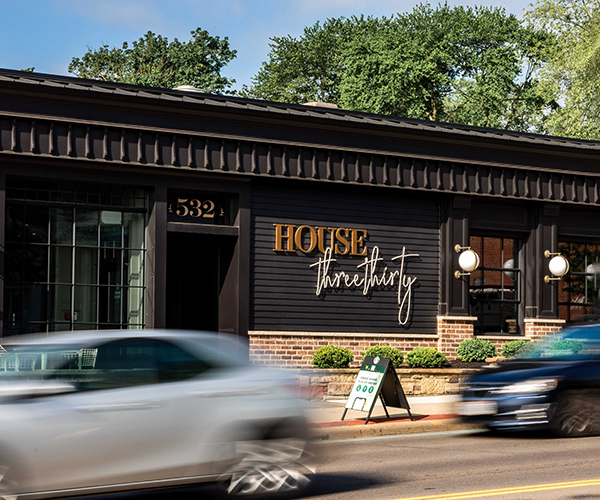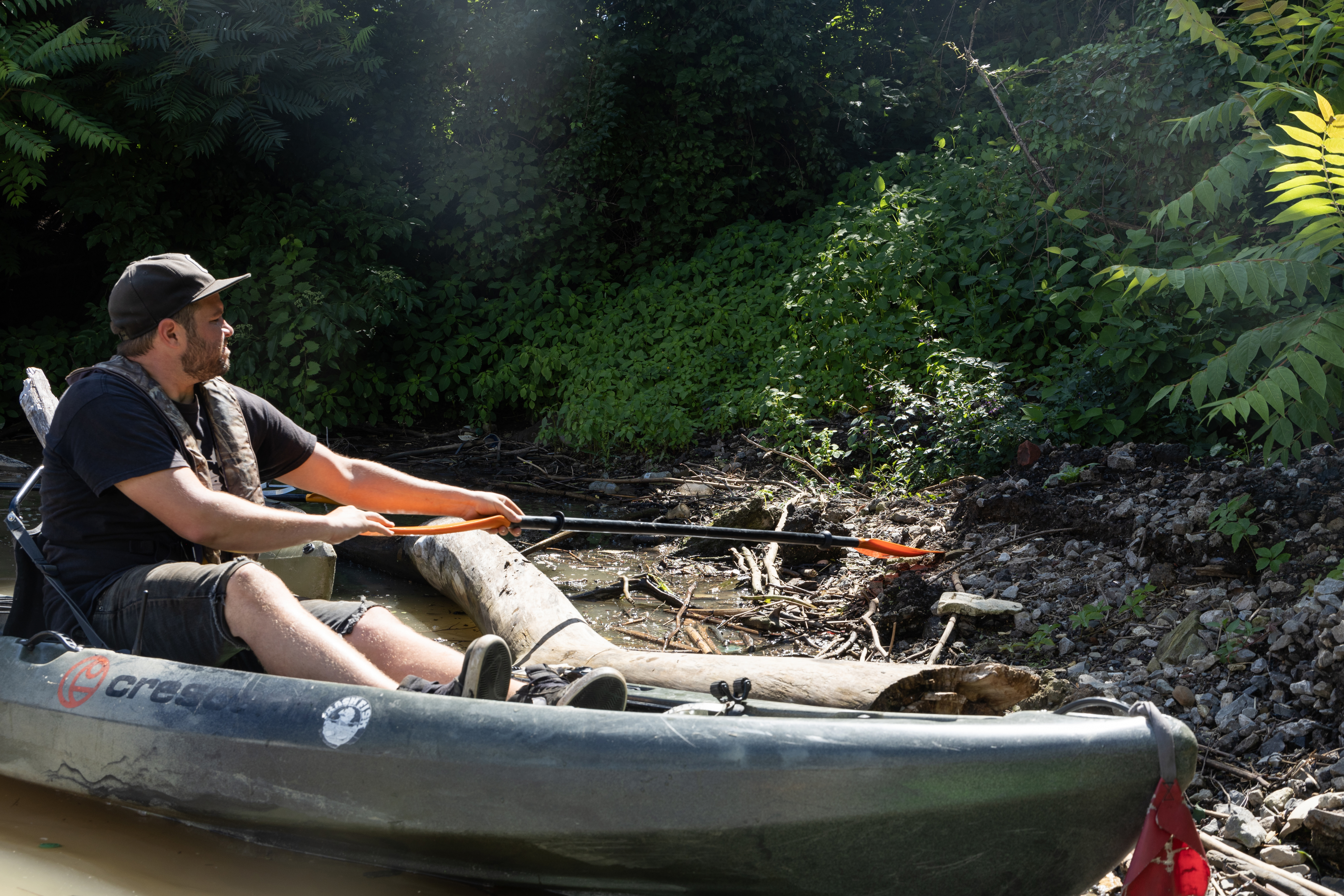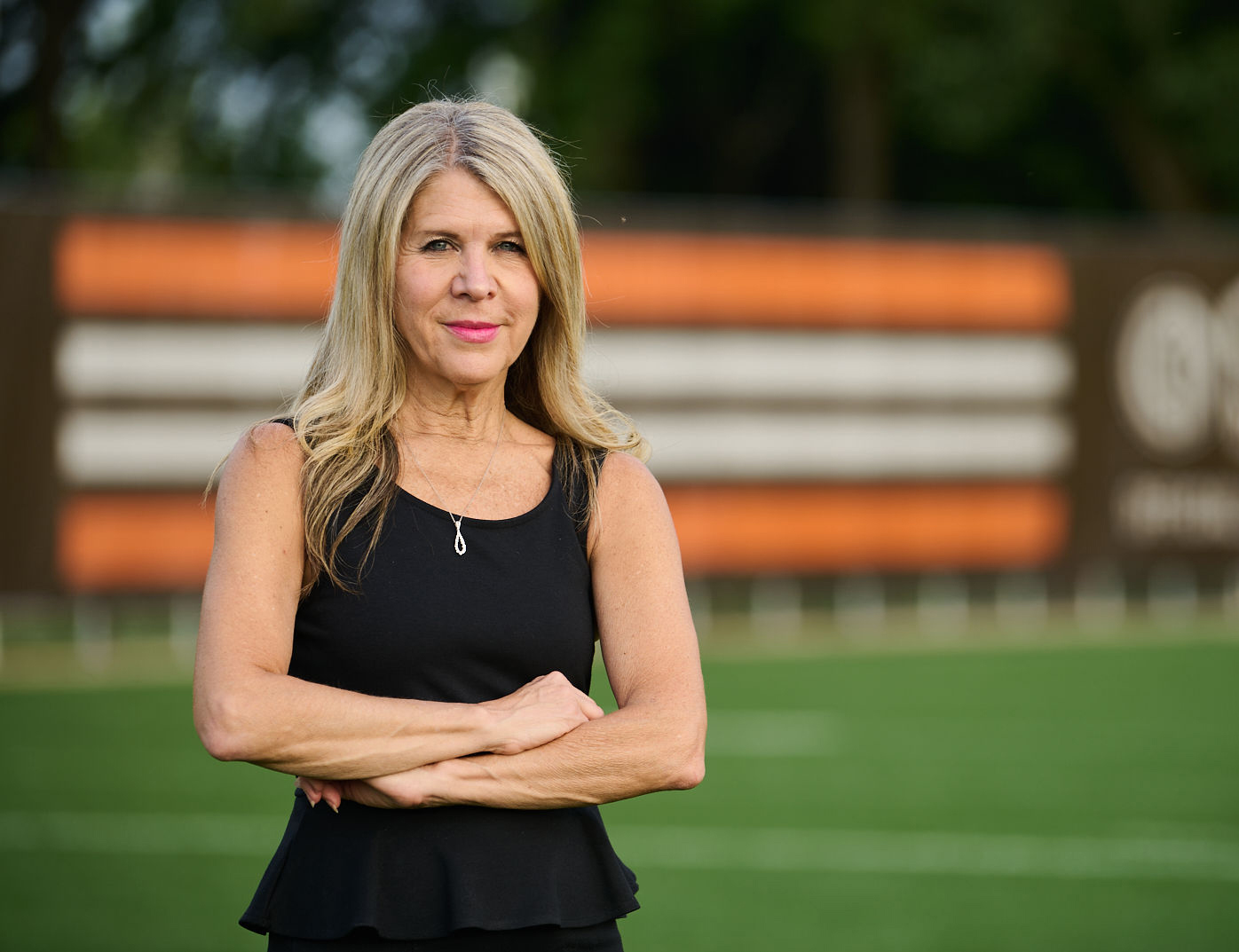How Cleveland Rallied Together In The COVID Era
by Dillon Stewart | May. 31, 2020 | 12:00 PM

PHOTOGRAPHED BY MATT SHIFFLER
Andrew Poulson arrives with a van and a pickup truck full of more than 5,000 flowers. It’s just after midnight on March 20 at Edgewater Park and he’s got a team of six friends and family members here to help him bring his vision to life.
He scurries over to the Cleveland script sign, a popular selfie spot, ready to turn the statue into a vibrant, bursting floral arrangement.
A perpetual doodler since architecture school, Poulson shows his team of novice designers a loose sketch of what he has in mind. As he assigns them each a corner, he encourages them to embrace their own creativity. But as the owner of Andrew Thomas Design, a company that creates flower arrangements for weddings, corporate events and funerals, Poulson acts as captain, in charge of blending each individual section into a cohesive piece.
“We want to pay ode to the sign,” he reminds his team. “We want to make it big and bold, but we don’t want it to block the view of the city.”
He situates a 10-foot birch tree, for example, just left of the sign so it won’t obstruct the skyline from photos. The group spends the next three-and-a-half hours hunched over, fastening each individual bunch of flowers — daffodils, lilies, tulips, carnations, hellebore and more — to the base of the sign using foam Oasis blocks, chicken wire and zip ties — loose enough for onlookers to take, but tight enough not to blow away in the lakefront wind. Luckily, the cool weather ensures the flowers won’t be dehydrated by the time early-morning runners hit the trails.
“Flowers have always given me so much joy,” Poulson says. “It’s so easy to fall down that dark hole right now with these scary times, but I want to send the message that joy prevails.”
However uplifting, these flowers were never supposed to be here. Weeks ago, they were scheduled to be the final touch that completed a wedding reception, brightened up the drab conference hall of a corporate event, congratulated a high school or college graduate or served as a reminder of a family member’s vibrant life at a funeral. But since the coronavirus crisis forced Gov. Mike DeWine to shut down the state in mid-March, these significant events have been postponed, drastically altered or canceled completely. Weddings have been held on front porches, corporate gatherings have switched over to virtual chatrooms and end-of-life services have been held in empty funeral homes, without the comfort of a handshake or a hug.
It’s not just major milestones that look different. Life has changed. Parents have become multitasking experts, working from home while their children take virtual classes, all while grocery store employees and delivery drivers work every day performing essential jobs to keep industries in motion.
Doctors, nurses and first responders have been working against the clock to save a city. While they risk their health to save others, life desperately hangs in the balance. Since
COVID-19 has spread throughout our nation, Ohioans have lost more than 1,600 friends, family members and coworkers.
The first death in Cuyahoga County, and the third in the state, was reported March 21. He was 91. On April 8, Kimberly Rew unexpectedly received a text message saying her father Robert Campbell, a 71-year-old military veteran, had died alone at Glendora Health Care Center in Wayne County, where he was staying temporarily to receive physical therapy. That same day, John Dawson, a 55-year-old officer at Marion Correctional Institution, became the first Ohio prison staffer to die of the disease. On April 21, Our Lady of Mount Carmel, a Catholic parish on Cleveland’s West Side, grieved the loss of 81-year-old Rev. Arcangelo Manzi, an Italian native who had recently celebrated his 50th year in the priesthood.
The nationwide death toll, which as of May 15 surpassed 87,000 among 1.5 million cases, will likely never be fully known. But each and every life in Cleveland has been affected in this moment of crisis, and Clevelanders have proven every cliche T-shirt slogan about resiliency true as we’ve marched ahead and found new ways to work, play, thrive and survive under more than 50 days of government-mandated stay-at-home orders.
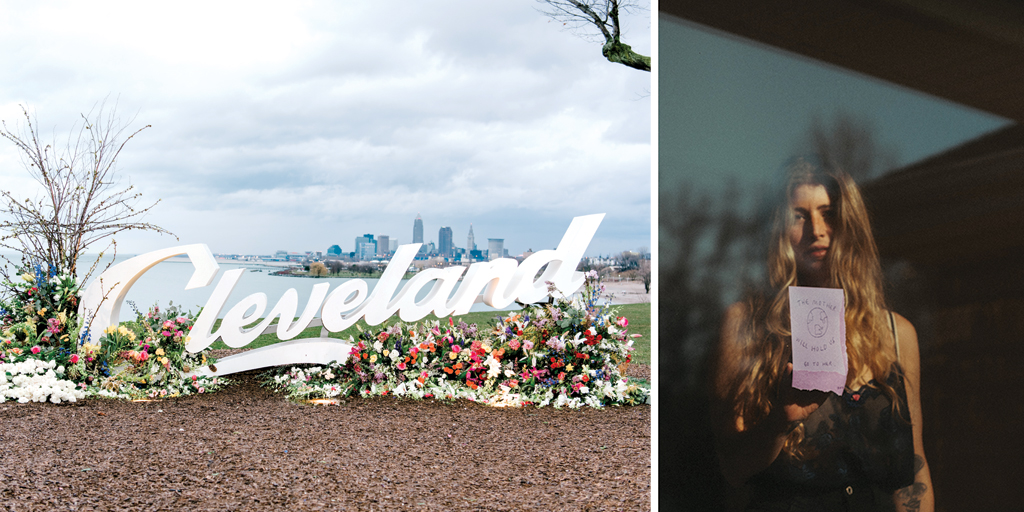
Led by inspiring individuals, creatives, grassro ots collectives, small businesses, corporations and charities, we’ve begun to shape a “new normal” for our city — one that is more creative, collective, inclusive and supportive of those who are struggling.
From actions as simple as sidewalk chalk drawings and signs declaring, “We support our health care workers,” to restaurants, manufacturers and makers shifting their businesses to provide for those in need, we’ve shown each other that we can build the new normal together, using each of our unique talents to create random acts of kindness.
“I think it just really challenges us as small business owners to be true entrepreneurs and pursue things that not only we’re passionate about, but that direct us in passion and creativity,” says Poulson.
As the flower arrangers finish up around 4 a.m., Cleveland’s skyline glows purple, lit up by the Terminal Tower’s red, white and blue neon lights and the dawning of a new day. Over the next several hours, word of Poulson’s creation spreads like wildfire across the city as vivid images of what he’s done circulate on social media and the flowers are taken to brighten the homes of isolated family members. By the end of the day, only chicken wire and a few stems remain, but the impact creates a long-lasting ripple effect.
“This is what I wanted to see,” says Poulson. “People walking through the parks with handfuls of flowers, with smiles and taking pictures — just creating that community was my goal.”
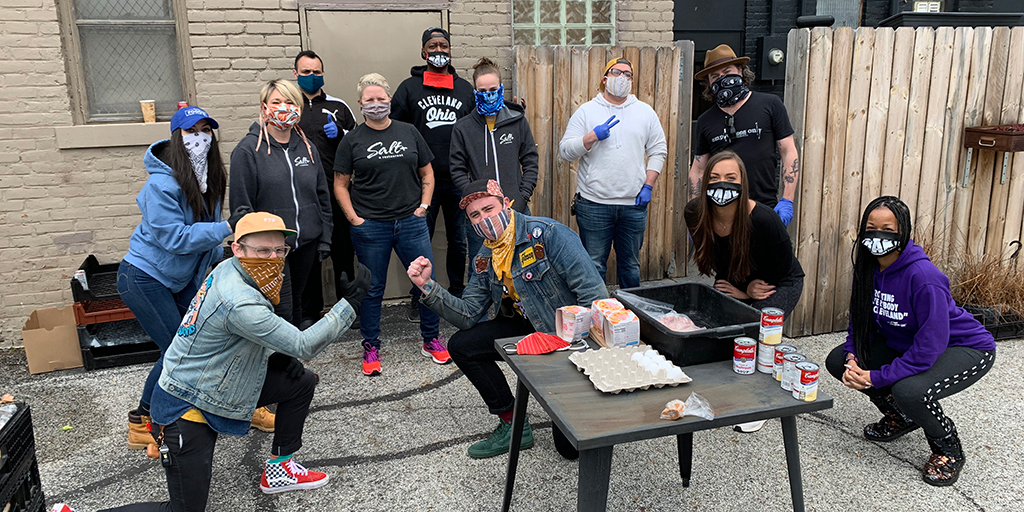
Audrey Burens approaches Cleveland Family Meal, a market-style food bank for out-of-work service industry members set up in the parking lot of Salt restaurant. Upon seeing the friendly faces of volunteers, the server’s cheekbones rise, indicating a smile hiding behind her white mask.
“Grab some hand sanitizer, and follow the line left to right,” says Vinnie Cimino, Cleveland Family Meal co-founder and chef at Summer House, the Lakewood eatery from which Burens is currently furloughed. “One person per table please.”
Burens knows the routine. She starts at the produce table, tossing a head of lettuce, potatoes, onions and oranges in a tote bag before moving on to bread, hot sauce, dried pasta, meat and prepared foods. Over the next few days, these ingredients not only serve as dinner for her twin 14-year-old boys and 10-year-old son, but it’s a way to occupy their free time. Even the prepackaged heat-and-eat lasagnas and chicken salad sandwiches come in handy between bouts of schoolwork.
“They are insatiable,” says Burens, as one of the lanky twins runs up from the car to help her carry the week’s haul.
The single mother’s laid-back demeanor hides a difficult truth. Burens is one of the more than 1 million Ohioans who have found themselves out of work in the first six weeks of Ohio’s pandemic shutdown, which forced restaurants to close or transition to takeout on March 15. Her unemployment check of about $300 every week barely covers groceries. The National Restaurant Association estimates at least 8 million of the more than 30 million out-of-work Americans come from the service industry. Its Ohio branch found that 100,000 restaurant employees had been laid off in the first three weeks of the state’s shutdown alone.
“Cleveland Family Meal has saved my life,” Burens says. “I’ve gotten pretty much every meal here since the shutdown. We’ve probably been eating better in quarantine than ever before.”
As an employee of Summer House, she was one of the first to benefit from what later became Cleveland Family Meal. Led by former Greenhouse Tavern chefs Cimino and Ryan Boone, the small plates-focused restaurant was celebrating its first successful week in business when Gov. Mike DeWine’s order was enacted. Knowing their staff of 50 was in for hard times, Boone and Cimino started sending them, as well as friends from other restaurants, home with any perishable products in the kitchen.
“We had all this stuff in our coolers, and we just wanted to try to help as many people as we can,” says Cimino. “The response has been astronomical.”
Today, Cleveland Family Meal, named after the kitchen ritual of breaking bread together before the night shift starts, feeds hundreds of people each Thursday and Sunday. Food Conscious, a charity focused on strengthening the influence of regional food purveyors, has adopted the program, making it an official nonprofit. Donations have come from across the industry, including food wholesalers such as Sysco, grassroots charities such as Employees Only and other restaurants such as Salt and Hi and Dry. Over its first two months, it has sent nearly 2,400 out-of-work service industry members — and pretty much anyone else who comes to them — home with groceries and prepared foods. On May 1, it was even able to expand to Akron by setting up shop at R. Shea Brewing.
“We look at our industry as one big family,” says Cimino. “We’ve always looked out for everybody in one shape or form, and this is just an extension of that.”
Across the dining scene, chefs and owners have found ways to feed their communities, all while a range of dining establishments figure out how to shift to takeout. On March 22, Dante Boccuzzi launched his own Family Meal out of his namesake restaurant in Tremont. Each Sunday, the restaurant hands out entrees such as chicken Alfredo or Mexican rice, feeding nearly 1,000 people per week. For others, such as Gordon Square’s Banter and Cleveland Heights’ Goodfellas BBQ, serving the community has meant free meals for families in need and front-line workers.
“This industry is a human-touch, human-influential business,” says Boccuzzi. “People come in and you’re dealing with their emotions and their lives. There’s human contact all the time, and I think because of that is why the industry reacts this way. So many people depend on us.”
After an advisory group of more than 30 restaurant owners submitted a proposal to Gov. DeWine for safely reopening restaurants May 15 and 21, much remains uncertain about the future of Cleveland’s dining scene, as they’ll face smaller capacities due to socially distanced floor plans and uncertain customer bases. The National Restaurant Association predicts the industry will lose $240 billion by the end of the year with potentially 1 in 5 restaurants closing nationwide. Those bold enough to make predictions suggested a shift to fast-casual and meal-prep services.
But there’s hope for local restaurants. Spice Catering, which closed Spice Kitchen & Bar and has taken devastating, six-figure hits through June, is exploring options for a new concept. Meanwhile, Summer House was able to retain six salaried employees by rolling out its takeout menu May 4 and bring back an additional hourly employee May 11.
Whatever the future holds, Cimino, who plans to continue Cleveland Family Meal even after the crisis ends, believes the
COVID-19 era has sparked a philanthropic and supportive spirit throughout the restaurant industry.
“This is what we love to do. We love to serve people,” says Cimino.

Cleveland has been described as a foodie town, a sports town and a town that rocks. But more than that, we’re a town that loves to be entertained. Our days are spent exploring makers’ markets and museums while our nights roar on at Cleveland Browns, Indians and Cavs games, in concert halls and at lavish productions staged at Playhouse Square. Although our downtown’s economy thrives on this entertainment, it’s currently in jeopardy.
According to Cleveland.com, estimates of the potential economic toll caused by a shutdown of the entertainment sector for the remainder of 2020 alone surpasses $1 billion.
Our city’s largest and longest-standing institutions are still reeling. The Cleveland Metroparks canceled summer staples, including summer camps and the Edgewater and Euclid Beach Live concert series and laying off, furloughing or reducing the salaries of nearly 650 employees. The Cleveland Museum of Art, which was preparing a Pablo Picasso exhibit for this summer, expects a $5 million loss by the end of June. It’s also canceled programming at least through June 30 and furloughed about 30% of its 470 employees.
But all the world is a stage if you look behind the scenes. Across all platforms, artists and collaborators have turned to online audiences and virtual programming as a means of keeping hopes high and creators paid. The Rock & Roll Hall of Fame and the Cleveland Museum of Art have offered online tours and educational programming, while Cleveland Metroparks zookeepers host daily Facebook Live events that bring viewers face-to-face with elephants, tortoises, monkeys and more while touring the animals’ habitats.
Even the Rite-Aid Cleveland Marathon and the Cleveland International Film Festival transitioned to virtual experiences this year, while Playhouse Square’s Tri-C Jazz Festival, which canceled its June in-person programming, is exploring livestream options.
“The key was to deliver on our mission while closed and still have an impact on fans around the world,” says Rock Hall CEO and president Greg Harris, who plans on reopening the museum June 15. “Within this crisis, people needed music.”
The music scene faces unique challenges of its own. Every Thursday at 4 p.m., Beachland Ballroom co-owner Cindy Barber meets virtually with hundreds of music venue and event space owners as part of the newly formed coalition National Independent Venues Association. According to Rolling Stone, the organization estimates about 90% of its 1,300 venues don’t have enough cash on hand to last more than six months. The federal government’s Paycheck Protection Program has helped Barber pay employees and utilities, but that’s set to run out by July.
To gear up for the challenges ahead and to bolster resources, Barber hopes to ramp up the Beachland’s kitchen offerings, host 148-capacity “Tavern-sized shows” with guests six feet apart in the 500-capacity Ballroom and replace canceled outdoor music experiences, such as Larchmere PorchFest, with parking lot shows.
Although most industry experts don’t expect concerts, festivals and large gatherings to return until next fall, Music Cities Together, a joint initiative between Washington, D.C.-based Music Policy Forum and Austin’s Sound Music Cities, included Cleveland in a pilot program working to develop ways to safely reopen venues to the public. But the fear of where we’re headed remains.
“National touring is dying right now,” says Barber. “It might be into next year before we really get going again.”
In March, Barber’s local nonprofit launched the Northeast Ohio Music Relief Fund, a grant program designed to help financially support those in the music industry. It extended $500 payouts in its first round to eight of 12 applicants, including Ray Flanagan and Brent Kirby. Already, 94 more musicians have applied for the near-weekly grants as of May 14.
The Beachland Ballroom, the Grog Shop and the community development nonprofit Warehouse District, which has hosted musicians such as Austin Walkin’ Cane, Flanagan and Liz Bullock with its daily Coffee Break Concerts, have all begun using technology to start bringing music back to fans.
“These are paid gigs we’d normally have, but now they’re just on Facebook Live,” says Flanagan. “It’s an amazing way to keep musicians working during this time.”
To Ben Gage, an Akron musician who runs Gage House Sessions and hosts local artists in a livestream show, these types of developing opportunities have allowed Cleveland’s creators, musicians and arts institutions to collaborate in ways they never have before. He sees a place where livestream experts can partner with institutions and charities, who can in turn sponsor sets from local musicians, creating a space for everyone to rise.
“This isn’t going to replace live shows, but it can certainly augment it,” says Gage. “If you have to sell tickets for $50 where you typically sell them for $20 because you can only let a certain number of people in the door, maybe you can put together a $5 streaming package for people who can’t get in or simply can’t make it because they have to work or have kids.”
The Monday and Thursday livestream shows, which welcome local artists to his house or to socially distant spaces, are highly produced affairs. The audio runs through concert-level microphones and soundboards, while the video stream, powered by a third-party system, is crystal clear, featuring a rotating multiwebcam setup.
“We need to be collaborative, not competitive,” says Gage. “If we don’t fall into that trap, Northeast Ohio, Cleveland, Akron — we can become the spot for livestreaming. We could be the virtual Austin or Nashville.”
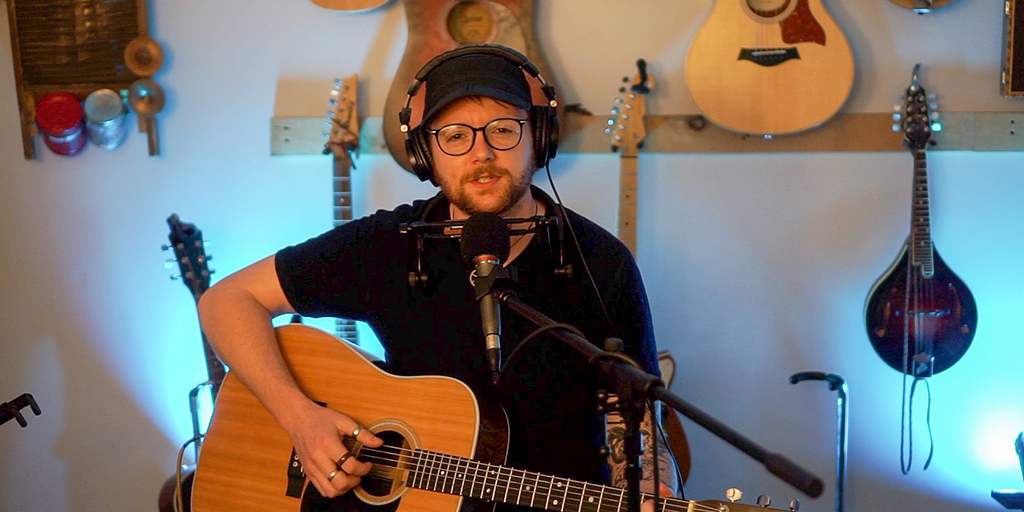
Moving forward, if all industries are going to thrive, we’ll need to work together to create a support system.
As Gov. DeWine rolled out his plan to reopen Ohio in April, he emphasized important protocols that citizens must follow to continue stemming COVID-19’s spread. While his stance on mandated masks has loosened a bit, the plan emphasized continued social distancing precautions in workplaces and retail spaces and a drastic expansion in testing capabilities.
As hand sanitizer shortages spread across the city, local breweries, wineries and distilleries realized they had all the supplies they needed to bolster state efforts. Cleveland Whiskey and the Cleveland Clinic partnered on a hand sanitizer project with Hofbrauhaus Cleveland, donating 1,000 gallons of beer to help production. Even as the industry experienced unprecedented alcohol sales, Gervasi Vineyard and Western Reserve Distillers joined Cleveland Whiskey in shifting part of its production from wine, handcrafted bourbon, vodka and gin to hand sanitizer.
“As soon as we realized there was a need, we started working around the clock to produce as much hand sanitizer as possible,” says Ann Thomas, chief marketing officer and co-founder of Western Reserve Distillers.
Even the fashion and crafts industry buckled down, with streetwear designer ILTHY and dozens of others making masks and donating a portion of sales and products to health care workers and those in need.
For B.J. Kowalski, CEO of Roe Dental Lab, stepping up to help with the statewide initiative was a no-brainer, because Clevelanders know what it means to work hard.
“We’re a unique place because we’re marrying technologically advanced thinking with the learned trait of working hard,” he says.
In early March, Kowalski was curious about how the crisis could potentially impact his business and his community. He began exploring how Roe Dental Lab, which typically makes veneers and other dental supplies, could make test swabs and personal protective equipment such as plastic face shields. With a highly trained 200-person staff and nearly 20 3D printers, he knew he could produce tests to meet statewide demand.
“The hardest part was really just taking the risk, but I knew it was the right thing to do for my staff, for my company and for the state of Ohio,” he says.
Afraid supplies might dry up, Kowalski invested in 500,000 swabs-worth of materials, including 36 more 3D printing machines and 660 gallons worth of sanitation alcohol.
The gamble paid off. On April 24, as DeWine revealed parts of his gradual, multiphased reopening of Ohio’s economy, he stressed that the state could not reopen without more adequate testing. He announced two public-private partnerships that would be vital to reopening the state and expanding testing, one of which was with Roe Dental Labs.
As of May 15, only 2% of Ohioans, or 244,577 people, had been tested for the coronavirus, but thanks to the new partnerships, DeWine announced the state would have the capacity to conduct 22,000 tests per day by late May — a long-needed resource to track and contain the spread of the virus.
“I never thought we would get any recognition for doing this,” says Kowalski. “I just knew we were in a unique position to help.”
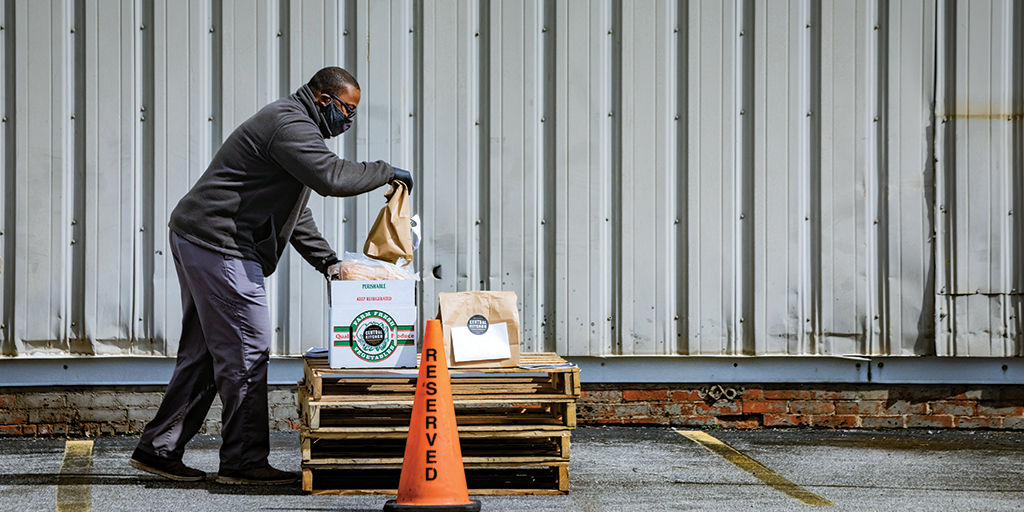
Cleveland’s response to the global pandemic has shown the huge impact of small actions.
For some, it’s providing financial support to those most in need. The Greater Cleveland Food Bank, which accepts monetary donations on its website, is a great place to start. The organization has distributed nearly 500,000 pounds more than it did last year and has moved its weekly distribution to the Muni Lot to keep up with demand.
Saucy Brew Works created the online Cleveland Tip Jar, which allows people to donate money directly into the Venmo accounts of service workers reeling from job loss.
Thanks to 2,000 donations, the Cleveland Foundation’s Rapid Response Fund has awarded more than $3.8 million to 65 nonprofit organizations, such as the Salvation Army of Greater Cleveland, Malachi House and Family Promise of Greater Cleveland.
“I always feel good after I see one of those feel-good stories about a neighbor helping a neighbor or a church doing a food drive,” says attorney Rebecca Maurer, founder of Cleveland Stimulus Pledge and owner of Maurer Law. “I think it’s important for folks to realize that anybody could be that person.”
Maurer launched the Cleveland Stimulus Pledge in March knowing some locals may be able to donate part of the federal government’s stimulus check back into the city’s economy. Since its launch, nearly 100 have pledged roughly $60,000 to the cause, supporting local charities or making purchases at independent businesses and restaurants across the city.
“I’m really proud of how far the message has gotten to inspire people to commit some of their stimulus money to their communities,” says Maurer.
Even those who don’t have the luxury of monetary contributions are pitching in. The Red Cross is seeking blood donors after an unprecedented number of canceled drives. Some are picking up groceries for elderly neighbors or those at risk in vulnerable communities. And artists are pushing their talents farther than ever before to keep spirits alive.
During a sunny week in April, artist Erin Guido was hired by the Snavely Group to paint over an under-construction spot in the front of the Forest City Bank Building.
Guido had been having a hard time feeling positive, but she went to work on the sign anyway. As her work progressed and her messages were revealed, crowds of onlookers formed. The owners of Sauce the City brought her food and a friend organized a Zoom call so she could listen to a violinist perform. The response was more than usual.
“Seeing people react in a positive way to the message motivated me,” says Guido.
When she was done, one message read: “It is So Good To See Your Face, Even If It’s Under A Mask Or On My Screen When You Have To Be So Far Away!”
The other: “We Are In This Together!”
But one passerby made a point to Guido.
“Someone told me, ‘While we’re all in this together, we’re not necessarily all in the same boat,’ ” she said. “We need to count on each other to get through this, but it’s important knowing that some people are kind of in it.”
Although we can’t yet measure the damage done to our local economy or all the lives that have been lost, we’re still doing our best to make it through these difficult times together. Sometimes, the easiest thing we can do is to show each other how much we care.
“Sometimes those small things almost count more than those bigger things, you know? At least to your neighborhood,” says Guido. “It shows that one person can use their amazing talents to really change all these people’s day.”
For more updates about Cleveland, sign up for our Cleveland Magazine Daily newsletter, delivered to your inbox six times a week.
Cleveland Magazine is also available in print, publishing 12 times a year with immersive features, helpful guides and beautiful photography and design.
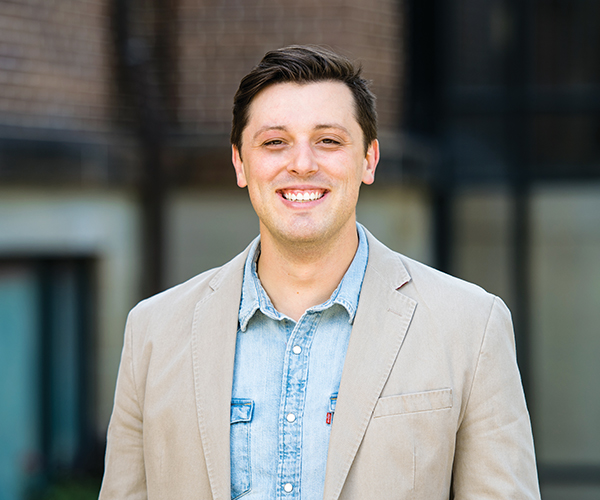
Dillon Stewart
Dillon Stewart is the editor of Cleveland Magazine. He studied web and magazine writing at Ohio University's E.W. Scripps School of Journalism and got his start as a Cleveland Magazine intern. His mission is to bring the storytelling, voice, beauty and quality of legacy print magazines into the digital age. He's always hungry for a great story about life in Northeast Ohio and beyond.
Trending
-
1
-
2
-
3
-
4
-
5


